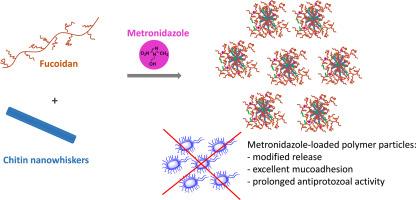褐藻糖胶和甲壳素纳米须的黏附性聚电解质复合物延长甲硝唑的抗原虫活性
IF 10.7
1区 化学
Q1 CHEMISTRY, APPLIED
引用次数: 0
摘要
提高具有抗菌和抗原虫特性的制剂(如甲硝唑,MET)的特异性药理活性是临床应用于治疗细菌感染的兴趣所在。在这项工作中,我们制备了基于甲壳素纳米须(CNW)和褐藻糖胶(FUC)的聚电解质复合物(PEC),其水动力直径分别为 244 纳米和 816 纳米,ζ电位约为 -22 mV,具有良好的粘附性。将 MET 加入 PEC 粒子可促进 MET 的持续释放长达 10 小时,对临床分离的阴道毛滴虫的抗原虫活性可维持长达 10 小时。持续的药物释放率、明显的粘附性、更高的药理活性和无细胞毒性使得所开发的生物聚合物给药系统有望进一步用于临床试验。本文章由计算机程序翻译,如有差异,请以英文原文为准。

Mucoadhesive polyelectrolyte complexes of fucoidan and chitin nanowhiskers to prolong the antiprotozoal activity of metronidazole
The improvement of the specific pharmacological activity of agents with antimicrobial and antiprotozoal properties (e.g. metronidazole, MET) is of interest for clinical applications in the treatment of bacterial infections. In this work, we prepared the polyelectrolyte complexes (PEC) based on chitin nanowhiskers (CNW) and fucoidan (FUC) with hydrodynamic diameters of 244 and 816 nm, a ζ-potential of about −22 mV and good mucoadhesive properties. The incorporation of MET into PEC particles promoted the sustained release of MET for 10 h and maintained the antiprotozoal activity against clinical isolates of Trichomonas vaginalis for up to 10 h. At concentrations of 1–3 mg/mL, the CWN-FUC-MET particles showed no cytotoxicity (HeLa cell line). The sustained drug release rate, combined with pronounced mucoadhesive properties, improved pharmacological activity, and non-cytotoxicity makes the developed biopolymer delivery systems promising candidates for further clinical trials.
求助全文
通过发布文献求助,成功后即可免费获取论文全文。
去求助
来源期刊

Carbohydrate Polymers
化学-高分子科学
CiteScore
22.40
自引率
8.00%
发文量
1286
审稿时长
47 days
期刊介绍:
Carbohydrate Polymers stands as a prominent journal in the glycoscience field, dedicated to exploring and harnessing the potential of polysaccharides with applications spanning bioenergy, bioplastics, biomaterials, biorefining, chemistry, drug delivery, food, health, nanotechnology, packaging, paper, pharmaceuticals, medicine, oil recovery, textiles, tissue engineering, wood, and various aspects of glycoscience.
The journal emphasizes the central role of well-characterized carbohydrate polymers, highlighting their significance as the primary focus rather than a peripheral topic. Each paper must prominently feature at least one named carbohydrate polymer, evident in both citation and title, with a commitment to innovative research that advances scientific knowledge.
 求助内容:
求助内容: 应助结果提醒方式:
应助结果提醒方式:


